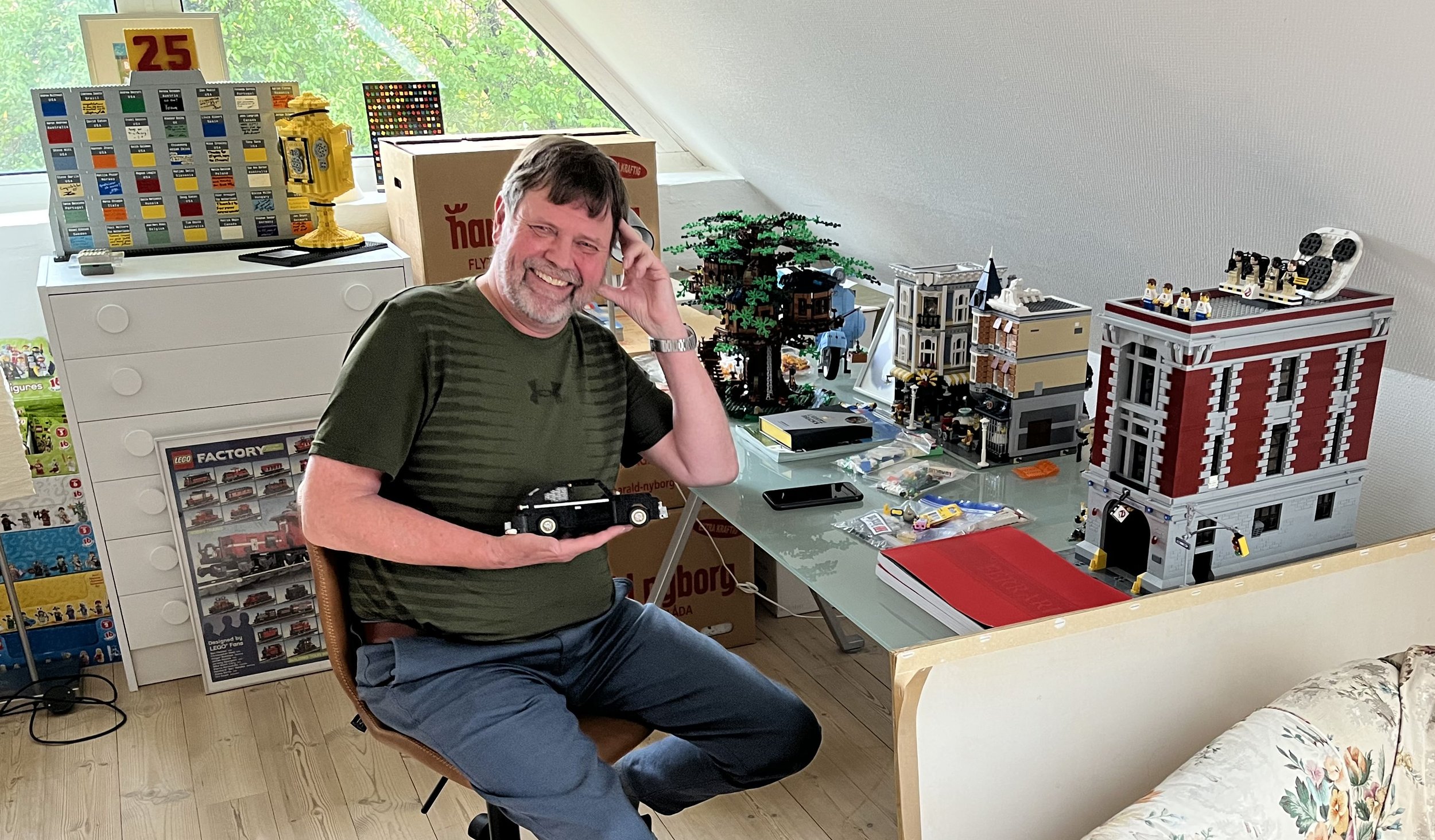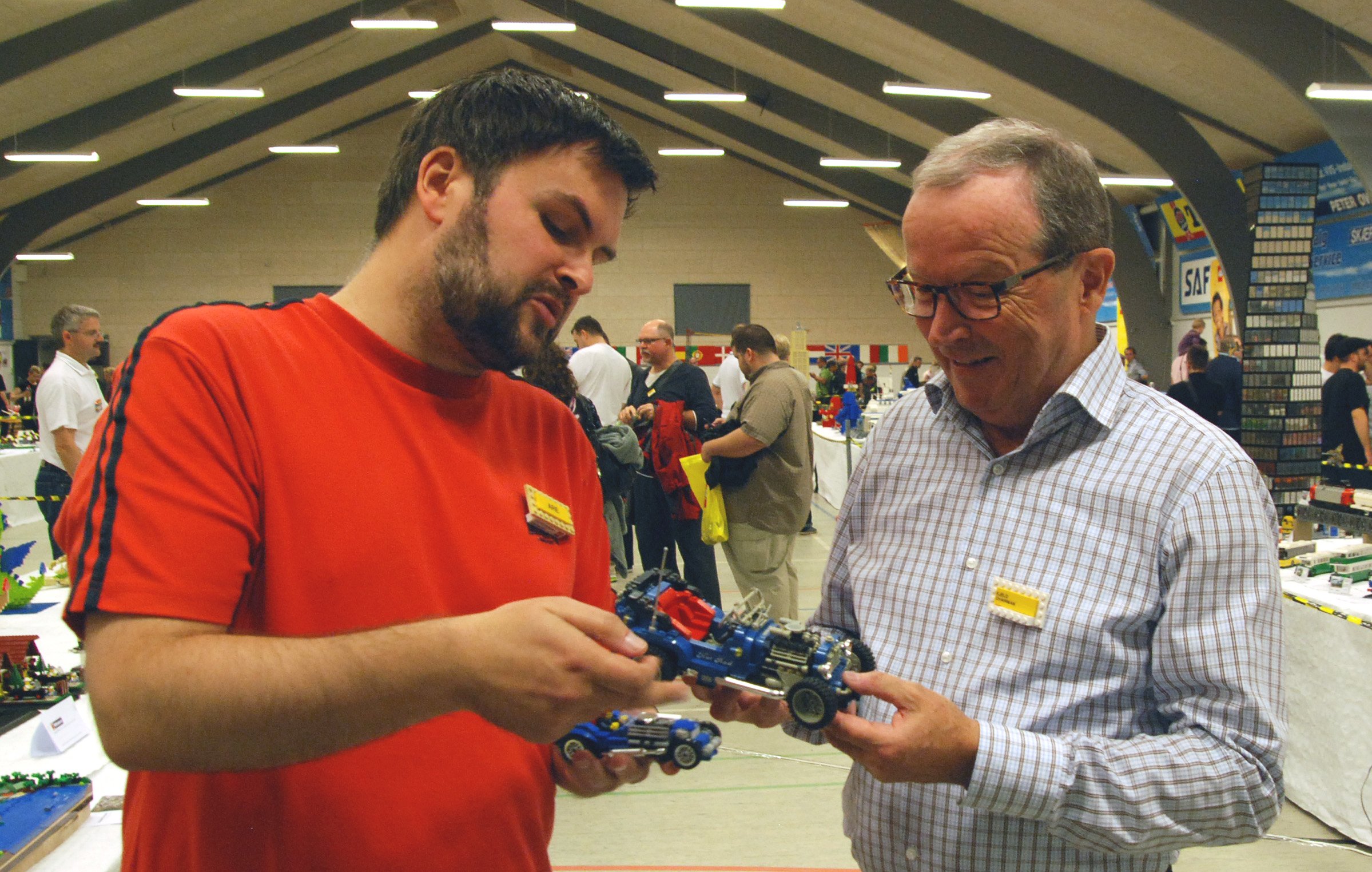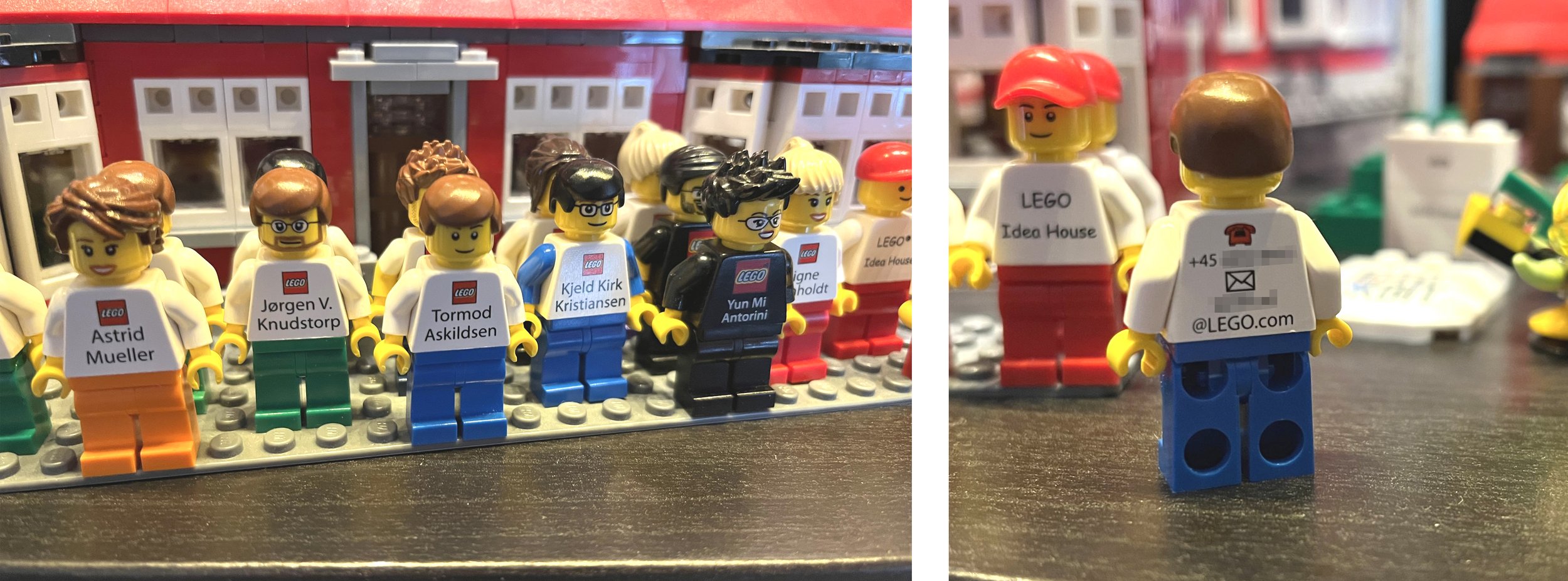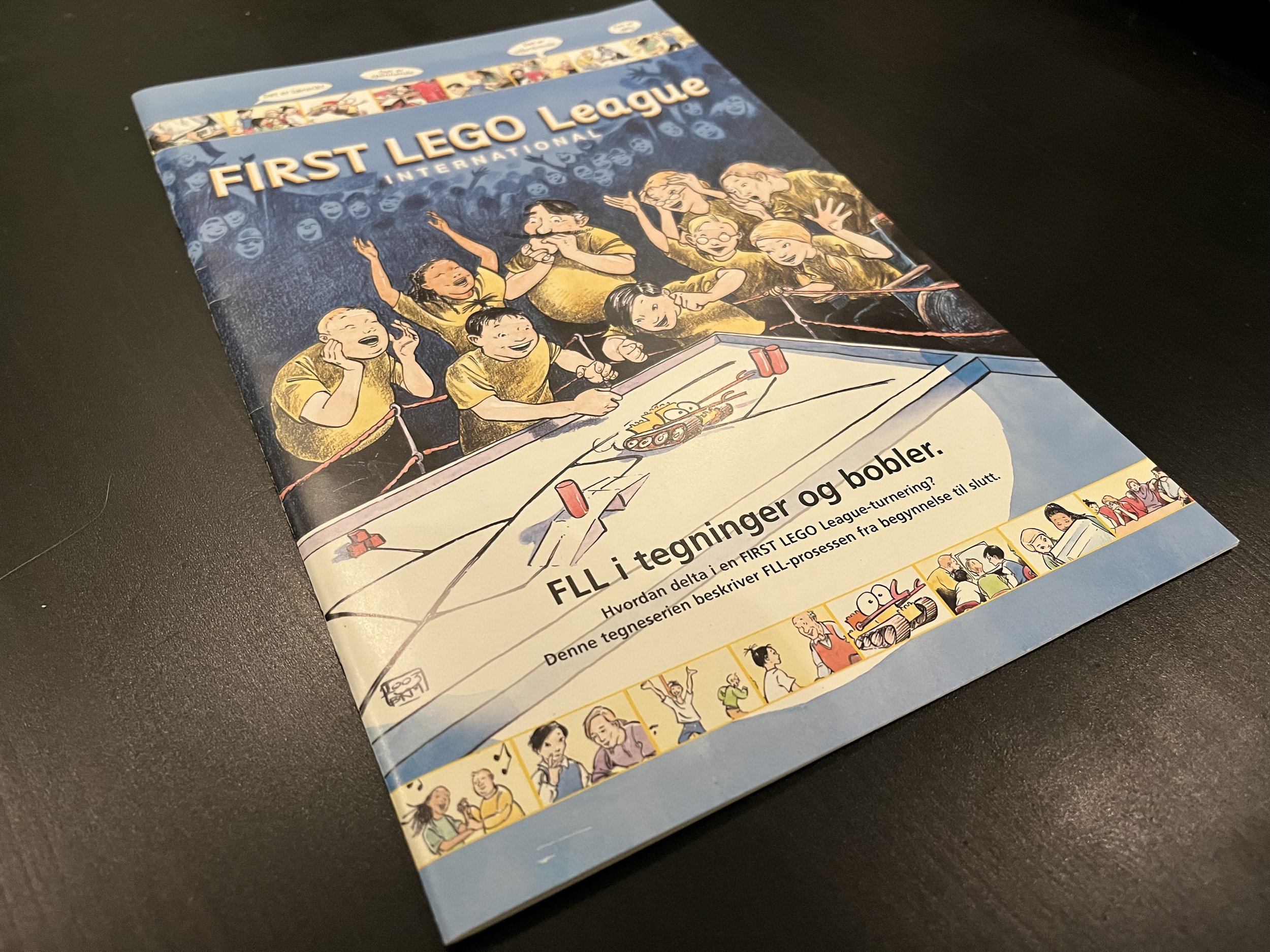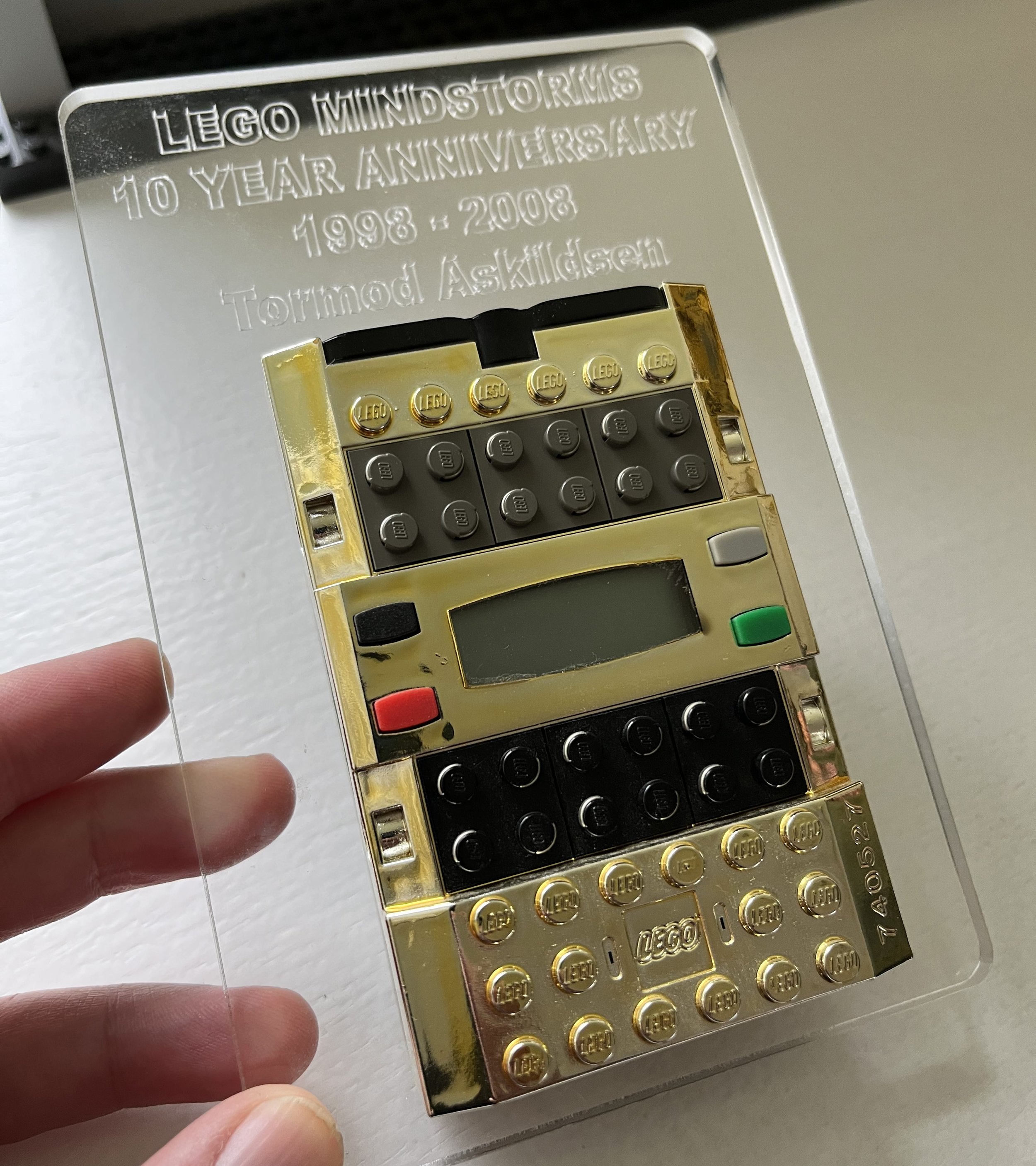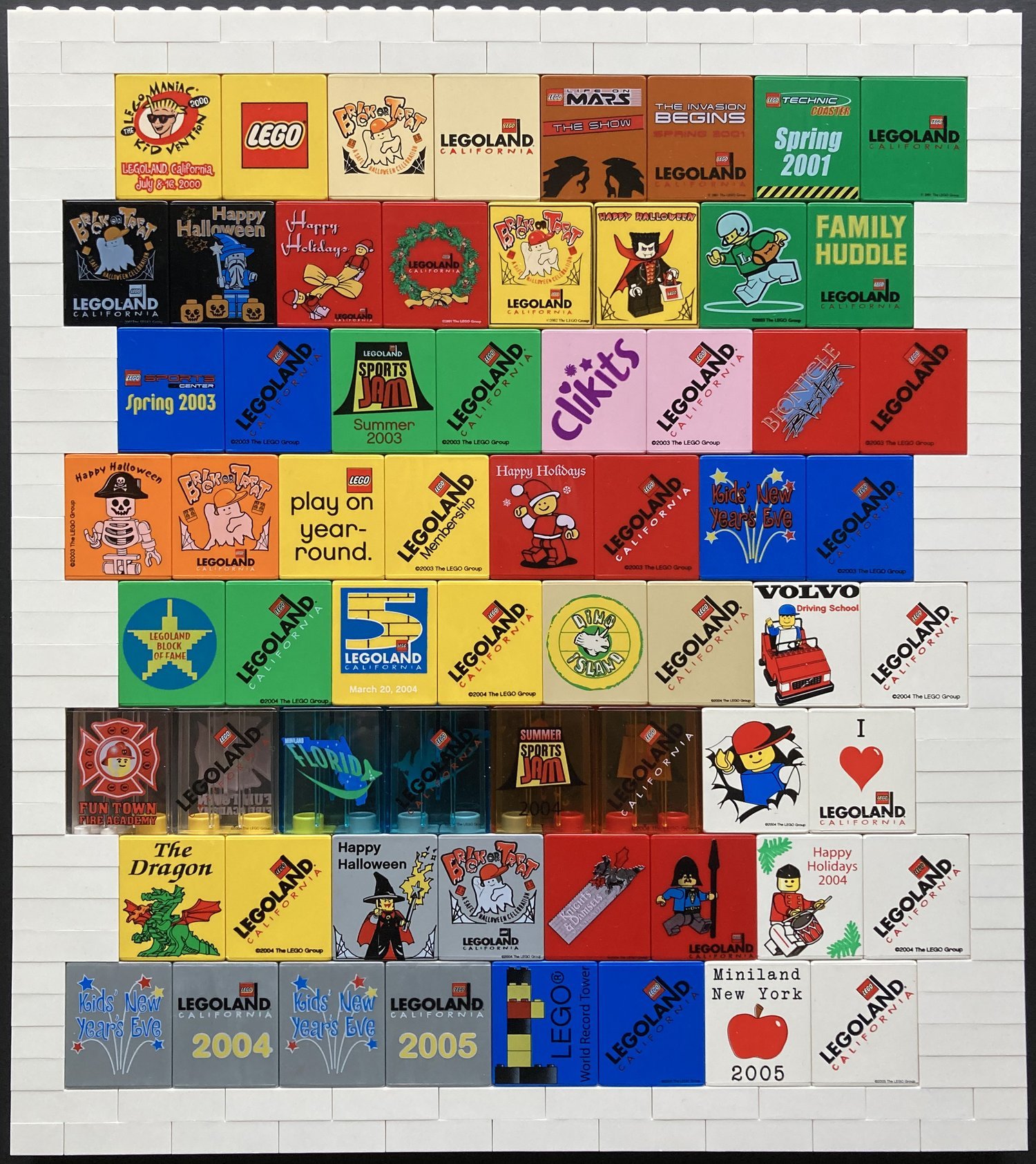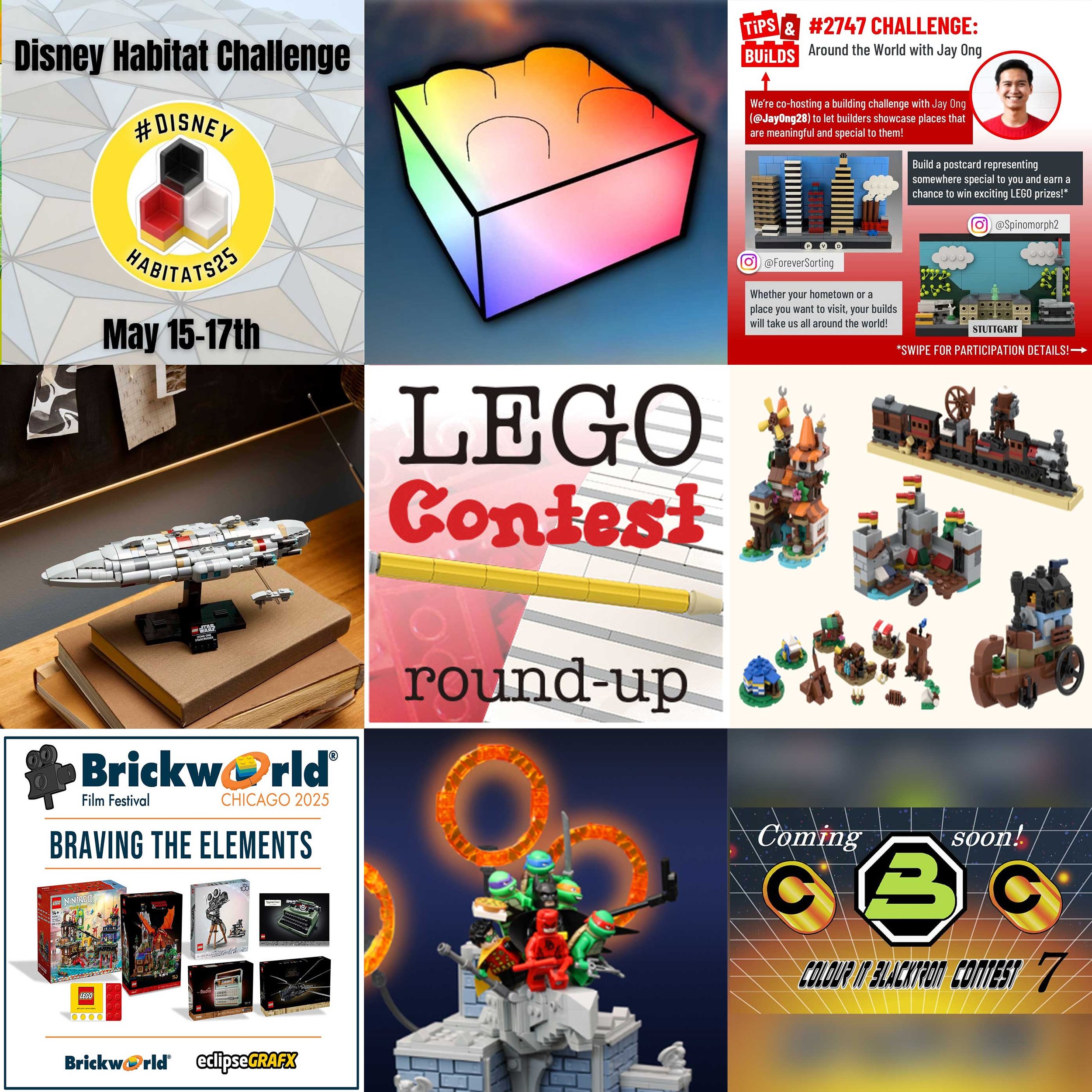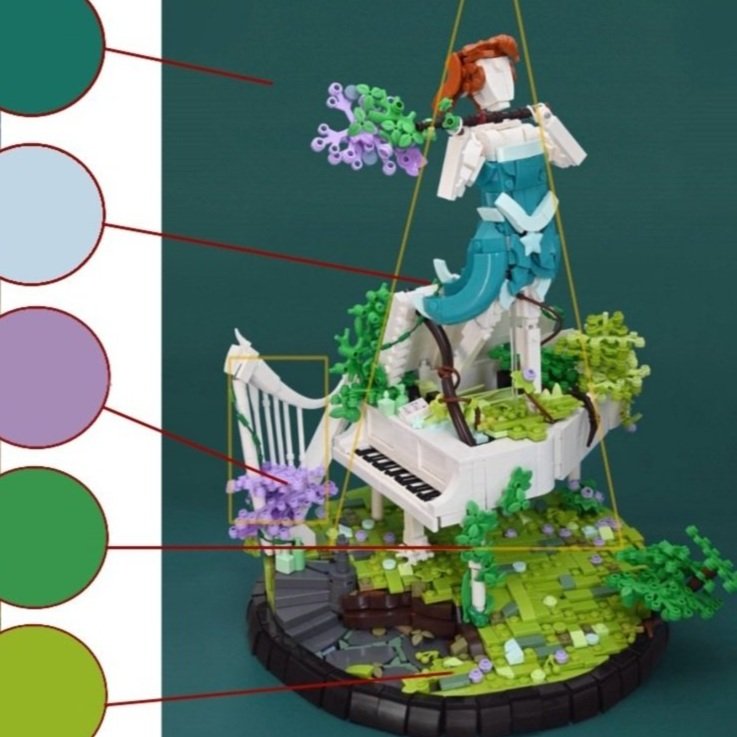Tormod Askildsen: One Last Chat with LEGO’s AFOL Advocate
/There’s a chance you don’t know who Tormod Askildsen is, especially if you’re relatively new to the LEGO hobby. But you should—and now that he’s retiring, we sat down for a chat. A long chat.
Tormod in his LEGO room, with a few of his treasures on display. There are many more to be revealed…
“For the past couple of months I’ve spent some time just reflecting on my 39 years in the LEGO Group, and there’s so much stuff that has happened. But I went over the years and tried to find out what got stuck in my mind, the things I remember—because if I dig deep, I certainly can remember a lot more.”
I’m in Tormod Askildsen’s car, and we’re heading to his house just outside Billund’s town centre. I have to admit that I had hatched this perfect scheme to visit the so-called Vault again, in the basement of the Idea House, the original LEGO factory in Billund, because it has been a while since I’ve been there. So I suggested to Tormod that that would be the perfect place to do the interview, with him surrounded by sets released by the company during his career… but he had a different idea:
The Vault, where I wanted to do the interview. Tormod’s idea was better
“Well, I’ve got this LEGO room in my house that I’m just starting to tidy up. It’s where I’ve stashed all the treasures I’ve collected over the years.”
Fair enough, Tormod. That is a better setting. And that is why we’re heading to his house now that he has picked me up from just outside LEGO House.
Championing the Cause of AFOLs
As I mentioned, you may not know who Tormod is. He’s been working for the LEGO Group since 1983, and especially from 2000 to 2015 he was the number one liaison working for better relations between AFOLs and the company. Well, maybe after this one other guy.
Kjeld and I, at my very first LEGO fan event in Skærbæk, 2012
“Kjeld (Kirk Kristiansen, if you were wondering) has always been incredibly fascinated by and interested in AFOLs, so I’ve had a strong ally in him. To him, the way that they get together, share ideas, build things, make things, explore building techniques, utilise the building system… that’s exactly what the LEGO experience is supposed to be.”
So when we at BrickNerd found out that he was stepping down, we immediately sent a request for an interview. How did we get in touch? Through his business card, of course!
Tormod’s business card in good company outside Ole Kirk’s House in my LEGO display cabinet
That’s the first time I’ve actually needed one of those elusive employee figures. I emailed him and he came back to me instantly, saying some very flattering things about BrickNerd and agreeing to sit down.
Opening up one of the treasure chests
When we arrive at his house and make our way to the first floor, trying not to step on the cute little kitten that is running between our legs (“We’re watching it for a family member”), it becomes clear that the choice of location for the interview was correct. It’s overflowing with LEGO artifacts—not unlike your typical AFOL’s hobby room, but there are quite a few sets here that would make the average collector green with envy. We’ll get back to some of those!
“I’m spending more and more time up here, just building sets or going over my collection. I’ve just started dismantling all the modular buildings, they’ve been sitting in our living room for a long time.”
Then Tormod sits down in the chair by his desk… and pulls out a list of 34 bullet points, spread over three sheets of paper. He came prepared! Over the course of the rest of this article, and a second part that will be published soon, this list will be our starting point. We won’t be able to cover everything—it took us the better part of two hours just to talk our way through it!—but you’ll get the essence, the important bits, and some pretty funny anecdotes along the way.
A Norwegian in Denmark
We have to start at the beginning though. I first met Tormod at the 50th-anniversary event for LEGO in Norway, “Vær med å bygge landet” (“Help us build the nation”) in Oslo in 2012—he’s a fellow Norwegian, after all, so of course he was there. But how did he end up in Denmark?
Bergen, Norway, where Tormod Askildsen planned to study
“My marks from high school were not good enough to get me into the Norwegian School of Economics in Bergen. So I started to look abroad and eventually decided to go to business school in Denmark. My brother had studied partly in Paris and partly in the US, and my sister took her bachelor’s and master’s degree in the UK, so it was relatively normal for Norwegians to travel abroad, but most of them come back.”
And then, as often happens at that point in life, love intervened.
Sønderborg, Denmark, where Tormod Askildsen ended up studying (Image via Wikipedia, credit Erik Christensen)
“I met my Danish wife while studying in Sønderborg. She finished a year before I did and eventually got a job offer from KIRKBI, in the legal department. She joined them in January 1983, and when I finished my education in May that same year, we had agreed that we would move to Norway. But because KIRKBI was closely related to the LEGO Group, and the LEGO Group was such a great company, she suggested we take a couple of years in Denmark first. I said OK, and applied for a marketing trainee position because I figured it could always be a good thing to have a couple of years with the LEGO Group on my CV. And I got that job, starting in September, even though I did say in the interview that was not planning to stay there more than two, maximum three years. We were going to Norway!”
So two years, maybe three, turned into 39. The beginning of Tormod’s time with the LEGO Group was spent dealing with things like market research and loose part sales, and then he moved to a department that would shape a lot of his career.
A DACTA set from the 1990s. Image via Brickset
“I worked for around 10 years in LEGO DACTA, which was called the “Institutional Department” when I started and is now LEGO Education. That was a pretty wild journey because we had a lot of resources—it was something that the Group, the family, wanted to develop—an educational division. We churned out so much different stuff—play tables, mosaics, a LEGO reading system with letters and numbers where you could compose texts and then photocopy them, and then we developed the so-called Interface B, LEGO’s second interface for robotics—still limited by wires, though—which launched in 1989.”
Hey, what’s this guy doing here? Read the text to find out
“Towards the end of my time with DACTA, I got involved with the Elvis project. I was asked to look into the market for children’s software—not robotic software, but everything else—and we called it Elvis because of the song “Are you lonesome tonight?”. It’s stand-alone software. Get it? We ended up recommending that the LEGO Group in one way or another had to enter that market because we could clearly see it was going to infect everything, around kids’ play. We also set up an in-house department called LEGO Soft, or something like that—we were used to doing everything in-house at the time—which ran for a few years. As the people who headed up the area left, we actually licensed with them instead: they created TT Games, which was later sold to Warner.”
A Much-Needed Change
Then, in 1995, came the first little “crisis” in Tormod’s career.
“I found myself doing something that wasn’t really meaningful to me. Sure, we worked with schools and education, but our target consumers were not kids, but teachers, curriculum writers, administrators, and so on. I’ve always been very passionate about how kids learn, and what conditions need to be in place for them to have a good and strong learning experience. That did not happen in most classrooms. The intention of our educational concepts was always to give kids a better learning experience, but we realised that 95 percent of the teachers were not willing, or able, to facilitate that. As a result, I grew just more and more frustrated in that job, and I asked if I could leave that position and start an area called just Home Learning.”
The name was a deliberate choice, it was about learning outside the school system, but not home-schooling.
The game-changing product that eventually came out of Tormod’s Home Learning project
“We started talking to kids and to parents, focusing a lot on the US market which was very significant for us, and did a lot of research. And we found out that to kids, learning was mostly boring. At the time, one of the few ways they could see it being interesting was that it involved technology, because they found technology fascinating, as kids do today. And so our aim became to develop a learning product that was so compelling that kids would want it for Christmas.”
That eventually led to LEGO Mindstorms—not only a product in a box, but also an online learning community.
The landing page of lego.com in 1996. we may still not be entirely happy with LEGO’s IT solutions, but they have come a long way. Image via Wayback Machine
“To get some help with this I put up an ad on LEGO.com—this was the same year we launched our website in 1996—and I got applications from all over the world, but I went with Russell Stoll, a guy from New York who had actually worked with the Danish Seamen’s Church in New York, so I felt that he understood a little bit of Danish culture. We got him a server—he worked out of his apartment—and he built legomindstorms.com, which was ready to launch in ’98.”
The Mindstorms Years
If there’s one other big theme that goes through Tormod’s career at the LEGO Group—apart from championing the cause of AFOLs—it is LEGO Mindstorms and everything that it brought along. Sadly, the company has recently announced that the LEGO Mindstorms name will disappear, and the team working with it will be moved into different areas of the business. But Tormod is full of stories of experiences he would never have had if it hadn’t been for LEGO Mindstorms.
Tormod with The 2017 “Women of NASA” IDEAS set, signed by… the actual women of NASA!
“For example, we started to work with NASA around 1996. Our way in was through the Planetary Society, an interest organisation around space exploration which lobbies activities towards NASA. We worked with them on a project called Red Rover, where we set up small sandboxes in different locations globally, and then remotely controlled a rover from one location to another to simulate what it means to actually control a rover on Mars. The time delay was six to eight minutes, so if there was more than one rover in that sandbox, you could get into problems. You gave it an order, then six to eight minutes later it actually acted on it—but the other rovers could have moved in the meantime! That is how NASA actually controls rovers on Mars.”
The whole reason that they wanted to collaborate with NASA was to inspire kids about space exploration.
“Together with the Planetary Society and the Niels Bohr Institute in Denmark, we made a DVD that had a little box on it, with an image of a LEGO minifigure. In the box there were magnets for collecting dust, and on the DVD were three brackets shaped as LEGO bricks. We planned to use those brackets to mount this DVD on the landers of both rovers going on the actual Mars mission in 2002, Spirit and Opportunity. NASA accepted it, so I actually have a picture of that little DVD sent from Mars. Pretty awesome!”
That little white oval thing is the DVD with the minifigure on it. On Mars! Image via The Planetary Society
The LEGO Group actually had not just one, but two technology projects in the works in parallel in the late ‘90s: Mindstorms, and a more traditional project called Cybermaster.
The CyberMaster unit, or “ladyshaver”. Image via BrickLink
“Cybermaster was using the LEGO Technic brand, whereas Mindstorms was an entirely different philosophy where we set out to develop a robotics toolkit. In the LEGO Mindstorms Robotics Invention system set, we didn’t even include building instructions, and some people actually returned the sets because of that—they thought that the box was missing something! But it was all about experimentation with robotics technology—we had idea books and stuff like that, but no step-by-step instructions. Cybermaster, on the other hand, had that. The technology was the same, but while the Mindstorms RCX was this stout, not overly designed brick, simply a battery box with some technology in it, the Cybermaster microcomputer was… we called it the Ladyshaver. It was a super-nicely designed object that included technology.”
The Mindstorms RCX brick. Image via Bricklink
The long development phase was leading towards a grand reveal, which Tormod admits stands out as maybe the one single day he has the fondest memories of during his entire career.
“It was a super hard and deadly frustrating project, and I had timeouts where I told my boss that I was so exhausted that I just couldn’t take it anymore. We worked so hard. But the reward was creating something that was truly new and just amazing. And then the launch happened, on the 27th of January, 1998, at the Royal College of Art in London, no less. That was absolutely crazy. I think we had 200 media from all over the world present.”
Two revolutionary products, LEGO Technic Cybermaster and LEGO Mindstorms, were introduced to the journalists. Mathematics professor Seymour Papert from the Massachusetts Institute of Technology (MIT), whose book from 1980 gave the name to LEGO Mindstorms, held a speech, and then it was time for interviews.
Kjeld Kirk Kristiansen at the Mindstorms launch in London in 1998. Photo courtesy of The LEGO Group
The Embarrassing Torbot Failure
“I was asked to bring my little Mindstorms robot, called “Torbot”, and get into a taxi that took me to the BBC for an interview in the BBC World studio. It was me and two journalists sitting in a studio with some chairs and a small table, and one of the journalists asked me, just before we went on the air, if I was looking forward to having an audience of 80 million people…”
And then it all went pear-shaped.
The home of one of the most embarrassing moments in Tormod Askildsen’s life
“In the middle of the interview, one of them asked me if I could demonstrate how the robot worked. I was prepared for that, I had tested it I don’t know how many times before I came into the studio. I pushed the Run button… and the Torbot ran to the edge of the table, promptly fell on the floor and disintegrated as only a LEGO model can. With 80 million people watching me demonstrate this awesome new technology.”
“Then the journalist next to me said, “Oh, but it’s LEGO! You can just put it back together, can’t you?” And I knew I would have about sixty seconds to do it. I picked up all the bricks, put them on the table, and by some miracle managed to build something that looked almost like it did before the crash. Then I started it again… and it actually worked. We had used a light sensor, and this time, when it came to the edge of the table, it stopped and reversed, as intended. But that… I don’t think I’ve ever felt so small, before, or later in my life. Things like that you never ever forget. I was told that they had everything on video, obviously. But I’ve never seen that video. And I’m not sure I would.”
Probably not what the torbot looked like after having waltzed straight off the table at BBC Studios. Image via Tormod Askildsen
I can reveal that as a TV reporter, I have some pretty well-connected colleagues, but sadly, we haven’t been able to dig up that video. So if you, dear reader, have a shortcut into the BBC system, feel free to reach out!
Mindstorms.com in 1998
Regardless of the embarrassing Torbot failure, the launch was a massive success.
“We announced it half a year before launch, prepared legomindstorms.com, got that up and running with communities and all that, and then we shipped the product in September ’98. I believe we sold 100,000 units in less than three months. On December 1st, we didn’t have any stock left. We couldn’t produce more at that time.”
Tales From FIRST LEGO League
Another side product of LEGO Mindstorms was FIRST LEGO League. To me, this is an outlier—it’s something that an AFOL might not even be aware of existing. It lives its life almost completely outside the AFOL world and doesn’t get promoted very much by the LEGO Group, either.
Norwegian version of a comic made in 2003 to promote FIRST LEGO League
“I can tell you why. The philosophy that we started out with when establishing the concept was this: We believe that there is a need for talent in science, technology, and engineering. Our partner FIRST (For Inspiration and Recognition of Science and Technology) did already have a robotics competition, but the lower age limit was 15-16, high school. That changed when Dean Kamen, the founder of FIRST, visited us here in Billund. He caught wind of the Mindstorms project before we launched it because he knew the president of LEGO Systems in Enfield, Peter Eio, and Peter had whispered to him that we were working on a product involving technology. Dean wanted to get to kids at a younger age and wanted to cooperate with us, setting up what he called a “little league”. And that was why we started FIRST LEGO League for ages 9 to 14. We were intrigued by Dean’s suggestion, and as FIRST was a not-for-profit organisation that had a lot of experience in organising robotics tournaments—not to mention some of the biggest companies in the US supporting them—so we joined forces.”
From the 2022 FIRST Championship. Image via FIRST
There was a commercial “price” to be paid for that companionship, though, and that has annoyed Tormod a bit ever since.
The FIRST LEGO League trophy, a gift for the 10th anniversary of the league
“Well, because FIRST was a not-for-profit organisation, the LEGO Group has never been able to promote FIRST LEGO League, as it could be seen as us taking commercial advantage of a not-for-profit program and hurt their not-for-profit status. And that is probably the main reason why you feel that FIRST LEGO League is living a little bit in the shadows. There is not a lot of high-profile promotion around it—the growth of the program is mostly driven by word of mouth. Still, there are more than half a million kids involved every year in more than 100 countries. I love that. Because FIRST LEGO League turned out to be exactly what I was looking for in learning: a program that put kids in charge of their own learning experience.”
In FIRST LEGO League, the teams consist of children aged 9 to 14, but every team needs to have an adult coach just to keep things in check. But while the thinking was that coaches would gather kids and sign up teams, that wasn’t always how it worked, as Tormod experienced.
Tormod’s own golden RCX brick, made for the 10th anniversary of LEGO Mindstorms
“I know that Steven Canvin wrote an article on BrickNerd a while back about the golden RCX brick. I have one of those—it’s sitting on the shelf behind me. There’s a picture next to it, on a spoof cover of BrickJournal that editor Joe Meno gave me as a gift, with me, Steven, and Søren Lund, who was our Project Manager on LEGO Mindstorms. Søren and I visited one of the early FIRST LEGO League tournaments in Minneapolis back in ’99, and one of the teams we saw consisted of four girls. And they were, pardon my language, kicking ass. They were absolutely amazing.”
However, to the two corporate guys from LEGO, it was also just a little bit suspicious. There was no coach to be seen, and they started to wonder if somebody else had built and programmed the girls’ robot for them to drive it on the table.
“Søren went pretty close and asked “how does this work?” and “what about that program?” and “how did you…?”—and from their answers, it was immediately clear that they had done everything themselves. So we asked them where their coach was. It turned out that they had basically just picked up some random young teacher in his ‘20s who didn’t have a clue about robotics just because they needed a coach over 18.”
The Arrival of the AFOLs
This article is already getting pretty long, but before we wrap up the first of two parts of Tormod Askildsen’s story we’ll have to touch on one last aspect of the Mindstorms chapter. Because this was the first time LEGO, as a company, really got properly in touch with adult fans. And that was not at all something they had planned.
The Mindstorms registration form included in the sets
“We actually put postcards in the Mindstorms sets for people to return to get feedback and some demographic data, and when those started coming in in early ‘99, we could see that half the people who bought the set were not in our target group. They were adults! Some of our colleagues in the US managed to track down some of them through online forums and Mindstorms.com, and invited six to eight of them to an event called MindFest, organised by MIT Media Lab.”
The reason for that invitation was not necessarily just out of curiosity, however.
MindFest 1999. Image via Jonathan Knudsen, Tech Insider
“These people, you see, were doing things that we were not so happy about—modifying the source code, developing their own software and so on. So our plan was to explain to them why they could not do that! We had this picture in our minds of these “evil hackers” doing everything in self-interest, taking advantage of us and destroying our concept… and then we met them. They were the most awesome people—nice, polite, all of them having grown up with LEGO bricks, and they loved their LEGO hobby. Needless to say, we buried that speech that we had prepared. Instead, we realised that these were super smart people, working with some of the biggest technology companies in the US. They had capabilities that we didn’t have in the company and could do things that we simply couldn’t do, so we decided to join forces with them. Now, that didn’t materialise until the next generation, Mindstorms NXT in 2006, but when we were working on that we actually brought a number of them in. We worked with a big community and four of them came to Billund. One of the sensors for NXT and one new element were actually based on input from the fans.”
Bringing “outsiders” into the LEGO Group wasn’t necessarily that easy though. Even if Tormod and his crew were enthusiastic about the capabilities of these people and what they could do for the company, there were others who immediately identified the possible threats.
AFOLs brainstorming… or, make that mindstorming, in Billund in 2008. Photo credit: Mike Brandl
“Oh yeah. Absolutely. We were all extremely wary in those early days. But the first contact we had with them was back in ’99, and the work on LEGO Mindstorms NXT wasn’t until 2005, so by then we knew them quite well… and then, of course, it was all about NDAs. We didn’t even talk to people without an NDA. But as I mentioned, when it came to collaborating with the fans, we had a strong ally in Kjeld.”
When Tormod starts talking about the AFOL community, it’s very easy to see that he shares this passion with the former CEO.
“Victorian on Mud Heap” by Mike Doyle—still my number one go-to piece when prompted to show the most impressive thing I’ve ever seen built with LEGO bricks
“Look at the LEGO System in Play. If you see it as a creative medium for technology, a creative medium for art, then you’ve got something that is inherently super complex. Six red 2x4 bricks can be combined in almost a billion different ways, and then you can add all the colours and, what is it, 5-6000 different shapes? But as a creative medium, it has a different set of restrictions than, say, clay, for example. Clay is organic, you can shape it, but being able to create such amazing things with square bricks? With that incredible level of complexity? It’s unbelievable. Former CEO Jørgen Vig Knudstorp compared AFOLs with Formula One racing drivers or concert pianists. That’s the level of competence we’re talking about.”
“Now, kids have a lot of fun with LEGO bricks, they mess around and put things together that look vaguely familiar. But to really take advantage of the building system, you need years and years of experience. Kids who join the LEGO experience when they are three or five, and then leave when they are ten, never get even close to that. That’s sad, but really hard to fix. And that’s why I’m so happy that we have finally, with the 18+ range, officially acknowledged that the LEGO experience could actually be something that continues throughout life.”
That feels like a good place to stop for now – because this is something there’ll be a lot more about in part two of Tormod’s story [now available]. The years after the turn of the millennium brought about an emerging AFOL community, the LEGO Group’s attempt to understand this community, and various smaller and larger crises looming. Stay tuned!
Do you have memories or anecdotes of your own related to Tormod’s stories? Did you return a Mindstorms postcard back in 1998? Have you participated in FIRST LEGO League, or maybe made a fool of yourself in front of 80 million people? Let us know in the comments!
Do you want to help BrickNerd continue publishing articles like this one? Become a top patron like Charlie Stephens, Marc & Liz Puleo, Paige Mueller, Rob Klingberg from Brickstuff, John & Joshua Hanlon from Beyond the Brick, Megan Lum, Andy Price, and John A. to show your support, get early access, exclusive swag and more.

